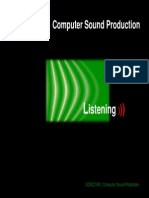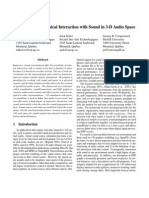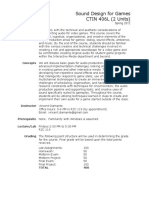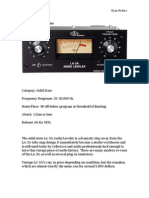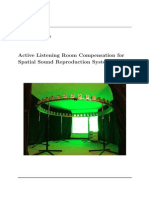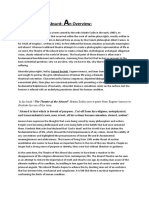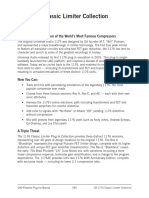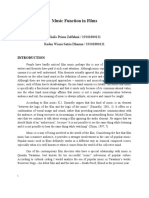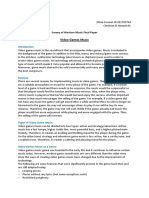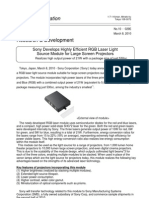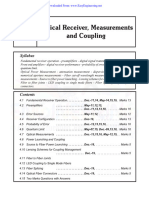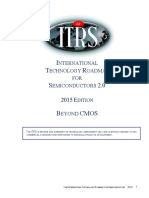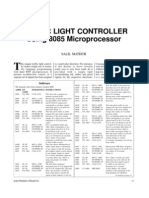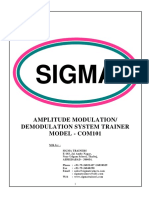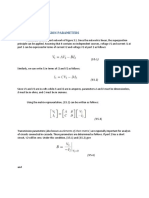Professional Documents
Culture Documents
BARCO Auro-3D White Paper
Uploaded by
cinemafuchsOriginal Description:
Copyright
Available Formats
Share this document
Did you find this document useful?
Is this content inappropriate?
Report this DocumentCopyright:
Available Formats
BARCO Auro-3D White Paper
Uploaded by
cinemafuchsCopyright:
Available Formats
Auro-3D: a new dimension in cinema sound
Barco
Auro-3D A new dimension in cinema sound
Authors
Wilfried Van Baelen Founder and Co-owner of Galaxy Studios Tom Bert Product Marketing Manager Barco Brian Claypool Senior Director Strategic Business Development Barco Tim Sinnaeve Market Director Digital Cinema Barco
Page 1 of 11
Auro-3D: a new dimension in cinema sound
INTRODUCTION
The introduction of digital projection in cinema theatres has spurred a revival in 3D movies. The first was Chicken Littlein 2005, and now according to box office returns they here to stay. The image quality re provided by digital cinema systems provides the immersive 3D experience that moviegoers have been missing for decades. But in contrast to this revolution of the visual experience, cinema audio has been evolving very slowly. In fact, other than adding a few more speakers to surround the audience with sound, the past 20 years have brought forth no significant innovations that have been able to make the aural experience as life-like and immersive as 3D imagery until now. 3D audio is the next logical step required to usher in the ultimate motion picture experience. When experiencing 3D Sound, one realizes that an immersive sound field creates more of an emotional response in the audience than image alone. Sound is related to emotion. Even when environmental sounds are heard unconsciously, they can have an impact on our emotional attitude and behavior. The importance of sound for business applications as well as for private individuals has been greatly underestimated. People feel connected with the environment through sound and the more natural the sound, the closer the connection. Furthermore, neurologists and sound engineers have long proven that sound can strongly influence the brain and the body. As George Lucas put it: sound is 50% of the movie experience. Still, the industry remains uncertain as to how to properly implement and use a new 3D sound experience. Auro-3D is the ideal, state-of-the-art solution because it integrates the full 3D experience into existing technology and standards with a flexibility and quality never achieved before. This new format was first showcased at the AES Conventions in Paris and San Francisco in 2006 and it has only improved since. Providing 3D listening formats that are compatible with current standards is just one of the contributions that Auro-3D has made. But what about the technology that will permit this new 3D format to be placed within the market existing distribution architectures and make it s compatible with all forms of multimedia? In this white paper, we'll explore the nature of human hearing, the shortcomings of current sound systems, and how Auro-3D addresses these shortcomings and the opportunities it can offer to your production pipelines and to commercial movie theatres.
Page 2 of 11
Auro-3D: a new dimension in cinema sound
THE PERCEPTION OF SOUND
Our brains perceive pictures very consciously, whereas sound is perceived rather unconsciously. Therefore, sound is sometimes considered to be less important, although film producers assert that sound creates at least as much emotional response as images do. Full True 3D Sound reproductions require a speaker layout with three spatial axes (X = width, Y = depth, Z = height) to produce true dimensional sound in space This means that simply the addition of . height speakers will ensure the reproduction of real 3-dimensional sound. Consumers, industry leaders and experts clearly see the evolution in audio entertainment evolving from a point source format (Academy Mono) to a single dimensional format (Stereo), later to the popular 2-dimensional format (Surround Sound), and finally to the ultimate 3-dimensional format: Full 3D Audio Format that is A compatible with downstream multimedia markets. Previous generations listened to mono systems, whereas the post-WWII generation grew up with technologies like stereo sound (which was spurred on by the invention of the television). The current generation is growing up in a digital surround soundenvironment. Today digital s surround sound can be produced by two different systems that play back this ambient sound the : Real 5.1 System, which uses one speaker per channel, and the VirtualSurround System which is usually matrixed and then derived from a stereo source. The speaker layout of 5.1 Surround Sound, which is placed in a 2dimensional plane (x= width, y = depth), was sold to the consumer as the solution for an immersive sound environment, but it did not fully deliver that experience. Furthermore, 6.1 and 7.1 surround releases still fail to fulfill this expectation, as they merely expand the depth of the horizontal plane around the listener. So, the current Surround Sound concept still has many shortcomings and is not able to immerse the listener in a True Sound environment(especially when you consider all that the new 3D digital technology can deliver). Whether that listener is gaming, watching a movie at a local theater, listening to music, or watching a sports event, the expectation of a more immersive sound field remains unfulfilled. Full True 3D Sound must be a unique experience that places the listener as the main observer in a virtual (close to reality) world. The listener must be positioned in the middleof the action and feel as if he or she is part of it. 3D Sound reproduction, which simulates the natural ambient sound experience much more closely than current surround systems do, also promotes greater acceptance of an immersive experience, since our brains are designed to experience enveloping sound rather than the 2-dimensional point-source sound reproduction today systems provide. s
Due to the technical limitations of current (2-dimensional) sound systems, and the fact that recently proposed solutions are incompatible with existing standards, no commercially viable solution for providing 3D sound has appeared on the market yet. The multimedia world is moving fast and is preparing a giant step to allow consumers to experience a higher level of entertainment by integrating 3D technology into gaming, broadcasting, cars, home-
Page 3 of 11
Auro-3D: a new dimension in cinema sound
cinema, theaters, music, mobile phones, streaming, PC, and other content. However, as history has shown, revolutions in entertainment technology always begin at the theater. 3D audio will be no exception.
INTRODUCING THE AURO-3D FORMAT
Full 3D sound in space can only be reproduced by using at least 8 speakers, positioned at the 8 corners of a cube. By adding a center and LFE channel, the smallest full 3D sound speaker layout is a 9.1 configuration as defined by the Auro-3D Format, which is fully compatible with existing 5.1 systems. This is illustrated below for a home cinema and an 11.1 configuration for a movie theater setting.
This basic speaker layout is very straightforward and based on the 5.1 standard: a Height speaker is added on each cornerof a 5.1 surround setup. This results in a two-quadraphonic layer system, with the addition of a Center Speaker and a LFE (Subwoofer) channel to be compatible with the 5.1 standard. It uses the smallest number of speakers to reproduce Full True 3D Sound, while remaining compatible with today s main standards: Stereo and 5.1 Surround.
Page 4 of 11
Auro-3D: a new dimension in cinema sound
The full Auro-3D speaker layout is defined for up to 13.1 channels, with 11.1 being the ideal solution for environments such as a commercial movie theater. Each sub-layout has its own fixed setup. It is important that we do not confuse the market with different layouts for a certain number of channels. While offering various configurations (each one is appropriate for a specific environment), they all offer the same basic layout. The Auro-3D speaker layouts 9.1 up to 11.1 are based on the 5.1 Standard: 9.1 Auro-3D: + 4 height channels (one above each corner speaker / array) 10.1 Auro-3D: + 5 height channels (+TS = Voice of God channel) 11.1 Auro-3D: + 6 height channels (+ Height Center) The Auro-3D speaker layouts 12.1 and 13.1 are based on the 6.1 or 7.1 Standard: 12.1 Auro-3D = 11.1 Auro-3D + Rear Center (6.1) 13.1 Auro-3D = 12.1 Auro-3D + Height Rear Center NOTE: Using the Auro-3D Codec, the 11.1 mix can be encoded into a 5.1 mix. There will also be an upgrade path to allow a 12.1 Auro-3D master to be encoded in a 5.1 mix. With standard surround sound or wave field synthesis based systems, the speakers are located only in the horizontal plane (= 2D), so this does not create the height effects that lead to a psychoacoustic sensation of being in a virtual environment. By applying real 3D Sound the most natural reproduction of sound you create more than just a new listening experience: this is a truly immersive experience that encapsulates the listener within the action. Direct (objects) and indirect (ambient) sounds coming from around and above the listener are created by using acoustical reflections in 3D, allowing the mind to correctly position the sources of the sounds. This makes 3D Sound the perfect match for the digital 3D visual experience.
THE ADDED VALUE OF AURO-3D IN CINEMA
The sound ecosystem in cinema has a number of players. The studios want to create the strongest possible story. The creative professionals on-set and in post-production want to add their unique contributions to that story by using the latest and most effective production technologies available. And finally, the exhibitors want to bring this story to the largest possible audience by creating the most immersive experience. Auro-3D helps each of these players achieve their goals.
Page 5 of 11
Auro-3D: a new dimension in cinema sound
STUDIOS
Of course, every movie is a story that is a meaningful artistic journey for those who create it, but it is also a business venture for the studios. It has a schedule, a certain level of quality, and a budget. Through its unique compatibility with existing formats and standards, Auro-3D can empower the story without compromising the budget. Adding 3D sound through Auro-3D raises a movie total sound budget by not even 1%. s While 3D audio technology may be regarded as a revolutionary disruptive technology, the tools available with Auro-3D allow for easy integration into existing post-production processes. Just like distribution today, only 1 print master is required, and that single distribution DCP supports all formats including all downstream release formats. 3D with a 2D budget! This also applies to DVD and BluRay releases, since the Auro-3D stream can fit into existing 5.1 streams. Auro-3D provides truly immersive 3D sound while being backwards compatible with existing standards. There is no chicken & egg problem, which has blocked the introduction of new technologies in the past. The master mix is first artistically created in 11.1 for the main release into theaters. Next, the 11.1 mix is folded into a 5.1 release mix in a quick, but artistically supervised, mix-down session. Then, this 5.1 master is encoded with the Auro-3D (11.1) channel information to create the final 5.1 PCM (uncompressed audio) master used in distribution and, potentially, in all other downstream formats. This upstream and downstream compatibility with current standards and production practices makes Auro-3D the best solution for nextgeneration audio and the only viable solution for the marketplace. What more, Auro-3D also introduces new creative opportunities. s Studios can now re-release their classic titles in artistically created 3D sound up-conversions, a function that the Auro-3D codec can also provide. Something to be considered seriously as the idea of rereleasing classic films in 3D visual gains momentum. While presentation technology has progressed to digital and then to Digital 3D, sound technology has not evolved very much in nearly 20 years. Auro-3D allows sound technology to catch up to the current visual presentation systems bringing a total immersive experience to the movie-going public.
CREATIVE PROFESSIONALS
Creative professionals such as the director, composer, sound designer, production sound mixer, recording engineer and re-recording engineer bring their unique expertise and skills to a motion picture production. Their talents converge to take the story to a higher level. Being creative, they look for more degrees of freedom to help tell a better story. Being professional, they do this without compromising quality or performance. Auro-3D helps achieve these specific goals. The artistic mix of the Auro-3D codecs gives creative professionals access to the greater freedom they are looking for, especially when creating a unique 3D visual experience. Having the capability to add 3D sound effects to support or enhance the visuals opens up a new level of creativity. Furthermore, this can be done without sacrificing the dynamic
Page 6 of 11
Auro-3D: a new dimension in cinema sound
range of the original PCM, ensuring that quality and control are maintained. Even when they apply some of the available automated mixing tools, they have the guarantee that the balance and sound color of their material are maintained.
EXHIBITORS
Exhibitors not only need to manage a multitude of movies coming onto their screens every couple of weeks, they must also manage and meet the increasingly sophisticated expectations of the thousands of patrons coming to their theaters expecting to enjoy themselves and escape the world for a little while. It understandable that exhibitors will hesitate to s re-invest in new equipment and re-design their auditorium layouts. But this is exactly where Auro-3D was designed to their requirements: upgrading from surround sound to true 3D sound is perfectly easy you simply add height speakers to the existing footprint. Furthermore, Auro3D sound processing is similar to, and compatible with, existing setups. Another important consideration for exhibitors is the impact of this new technology. Yes, the effect is stronger, more immersive and more natural than surround sound but will content be available to enjoy this on? And what about alternative content that was not made for 3D reproduction? All of these things were taken into consideration when Auro-3D was designed. As mentioned above, the standard is fully backwards compatible with existing standards, guaranteeing full support of all content. This guarantees compatibility with your pre-show and alternative content. There is also the capability to up-mix content: either in an artistic up-mix (as mentioned above in the production process) or in a more Auro-Maticmanner, while still maintaining the balance and color of the original content. Let not forget the new opportunities Auro-3D could bring to exhibitors. s With theaters investing in 3D, digital projection and 4K technology as ways to differentiate from the competition, imagine standing out in the crowd by pioneering sound in 3D Not only will this help you ! differentiate from other exhibitors, it will also pull people away from their homes to dive into this new experience that only available at their s favorite movie house! With the 3D visual experience already one step ahead, this is the opportunity for exhibitors to update their sound installation and create the most complete motion picture experience for their patrons.
THE AURO-3D CODECS
Up to now, the only way to achieve the reproduction of multi-channel formats has been by means of so-called Data Compression But the . market is evolving, and the current trend is to move back to the original digital uncompressed audio format called PCM (Pulse Code Modulation) which avoids the use of Data Compression codecs. This is evident in evolving broadcast and BluRay specifications and even the DCI spec, which specifically calls for the use of uncompressed audio. This trend is occurring as the various lossydata compression systems for audio (Dolby, DTS, MP3, etc.) prove to be incompatible and extremely difficult to use while maintaining a philosophy of single format distribution. Moreover, compression formats can create sound distortion, causing a loss of fidelity and mental fatigue in the listeners.
Page 7 of 11
Auro-3D: a new dimension in cinema sound
Due to these shortcomings and the upcoming new trends and needs in the market, a highly intelligent new invention, called the Auro-3D Codec, has been developed over a number of years. With many advantages compared to other data compression based codecs, it is also easy to adopt because it relies on the uncompressed digital audio standard (PCM) that is integrated in every audio-related device. To add a 3rd dimension to a sound-scape, a solution is needed to fit the artistic mix in the available channels. For this reason, people think they must continue with data compressed formats. However, these suffer from too many compatibility issues, latency, distortion, and a loss of fidelity created by perceptual masking. So, for many reasons, everybody would like to move back to the uncompressed quality of PCM, but they worry about limitations in bandwidth. All these issues are solved due to the way the Auro-3D codec allows mixers to create an artistic and dynamically controlled PCM signal that contains two or three other PCM signals without any audible loss. The master of that mixed information is still a standard PCM signal with the same sample rate as the original mixed tracks. This means that, in the PCM domain, we can create multiple distributions in just one 5.1 master. This 5.1 PCM master carries these formats as unperceivable metadata and can be played back on every audio device that supports 5.1 PCM. Using the Auro-3D codec, all audio standards (Stereo, 5.1 and AURO3D) can be integrated into just one standard 5.1 PCM stream, which will play back on every 5.1 Surround System. Moreover, one standard 5.1 PCM stream is able to include all past, new and future audio standards: Stereo, Surround 5.1 and AURO-3D (18 channels in total) integrated in the 5.1 Standard PCM stream, which plays back the original 5.1 mix without using a codec. This means that, when a movie is mastered with the Auro-3D codec, anybody who doesn have an Auro-3D System will t still hear the 5.1 tracks in exactly the same quality as they normally would have had in standard 5.1 Surround. But if they have the Auro-3D decoding system, the engine will extract all of the hidden information from that PCM signal and put it back in its original 3D audio format without any audible compromise! How does it work? It is generally accepted that the dynamic range of a final mix master for end-users does not have to be more than 20-bit (= a dynamic range of about 120 dB). No soundtrack has such an unrealistically high dynamic range that is, the difference between the loudest and the softest parts of the audio is 120 dB. Classical music is known to have a much higher dynamic range than pop music (which has an average of max. 20 - 30 dB), but the dynamic range of classical music will not be more than the dynamic range of an orchestra, which is never more than 120 dB between the softest and loudest parts of the composition. In fact, the dynamic range of mastered sound (re)production will rarely exceed 96 dB (slightly more than the dynamic range of a 16-bit compact disc). In many cases, the dynamic range is compressed during real-time distributions to avoid the dramatic differences in audio level. This form of compression is used in almost every television and radio broadcast facility today.
Page 8 of 11
Auro-3D: a new dimension in cinema sound
This is not the case during the workflow (before the final master is made), where it is still important to have 24 bits providing enough headroom for mixing without any compromise. But as soon as the final mix is made, 20-bit PCM masters do have uncompromised perfect audio quality. In fact, during a speech at an ICTA seminar in January 2011, industry veteran Tomlinson Holman explained to the public that 24-bit resolution distribution masters are overkill and he explained why lower , bit resolutions (like 16-20 bit) provide an adequate dynamic range to reproduce a film soundtrack accurately. In summary, the Auro-3D system turns all kinds of incoming sources into a Fully Immersed 3D Sound Experience. Without an Auro-3D system, the 5.1 Surround standard applies, without any noticeable difference in quality. Auro-3D is the only audio technology that is the logical choice for next-generation sound production, distribution and reproduction.
Page 9 of 11
Auro-3D: a new dimension in cinema sound
CONCLUSION
From a technical perspective, Auro-3D has many advantages over other new audio technologies. Auro-3D enables single inventory distribution and uses no lossy compression system it simply embeds extra channel information in the least significant bits in a 24-bit audio stream. This innovative and unique approach allows Auro-3D content to be transported using the market current standards. Furthermore, it s enables mix stage quality with less bandwidth than other lossless data compression techniques. Plus, it does all this with ultra-low latency enabling near to real-time performance making it the fastest audio decoding technology on the planet. Advanced mixing and mastering tools are already available: e.g. plugins for AMS/Neve consoles and Digidesign / ProTools systems. Compatibility with location / production sound has also been considered: new recorders and microphones for 3D sound are readily available and can be implemented using existing gear. Regarding the in-theater setup: Auro-3D is compatible with today auditoriums and mix stage design. s Additional speakers and amps to support the Auro-3D format cost a fraction of the investment required for other systems that have been proposed. Auro-3D is the perfect match for the visual 3D experience, providing the most natural and immersive movie experience imaginable. Being tuned to the needs of theater owners, studios and creative professionals, Auro-3D has the best offer on price, size and quality for the only real 3D Sound experience on the market. Representing the next-generation 3D Experience, Auro-3D provides for easy installation above existing surround speakers while maintaining backwards & future compatibility.
Page 10 of 11
Auro-3D: a new dimension in cinema sound
REFERENCES
[1] Burkhead, M.D. "Manikin Measurements." Industrial Research Products, Inc. (5/15/2007). http://www.knowleselectronics.com/images/products/pdf/KEMAR_Manik in_Measurements.pdf [2] Coppin, Sarah, et al. "Sound Localization Using Head Transfer Functions." Rice University. (5/15/2007). http://www.ece.rice.edu/~crozell/courseproj/431report/ [3] Head-related Transfer Functions, or How we Localize Sound. (5/15/2007). http://umsis.miami.edu/~tdallman/acoustics/hrtf/ [4] Institute of Sound and Vibration Research (5/15/2007). http://www.isvr.soton.ac.uk/FDAG/VAP/index.htm [5] Loomis, Jack M. "Psychoacoustics." AccessScience@McGraw-Hill. 4/10/2000 (5/15/2007). Michigan State. "Localization of Sound Sources." http://www.pa.msu.edu/acoustics/loc.htm [6] Wenzel, Elizabeth M. "Virtual Acoustics." AccessScience@McGrawHill. 11/23/2004. (5/15/2007). Wong, Lawson. "Multi-Speaker vs. Virtual Surround." Popular Mechanics. July 2005. (5/15/2007). http://www.popularmechanics.com/technology/upgrade/1752292.html
Page 11 of 11
You might also like
- AuroMax White Paper Final PDFDocument21 pagesAuroMax White Paper Final PDFAmarnath ANo ratings yet
- Auro 11-1 - A New Dimension in Cinema SoundDocument11 pagesAuro 11-1 - A New Dimension in Cinema SoundGarapati SitaramNo ratings yet
- Dolby Atmos Next Generation Audio For Cinema White Paper PDFDocument18 pagesDolby Atmos Next Generation Audio For Cinema White Paper PDFrjroy196No ratings yet
- How Surround Sound WorksDocument5 pagesHow Surround Sound WorksSK_shivamNo ratings yet
- Introduction To Ambisonics - Rev. 2015Document25 pagesIntroduction To Ambisonics - Rev. 2015Francesca OrtolaniNo ratings yet
- Multi Channel MasteringDocument17 pagesMulti Channel MasteringRafael Lima PimentaNo ratings yet
- Ambisonics 1 - General System DescriptionDocument13 pagesAmbisonics 1 - General System DescriptionaffiomaNo ratings yet
- Prospects For Transaural Recording - Cooper e BauckDocument19 pagesProspects For Transaural Recording - Cooper e BauckPeloDiRocciaNo ratings yet
- Ambisonics The Sorround Alternative - ElenDocument4 pagesAmbisonics The Sorround Alternative - ElenaffiomaNo ratings yet
- Improve Your Surroundings - AES Scotland PresentationDocument60 pagesImprove Your Surroundings - AES Scotland PresentationandrewhorsburghNo ratings yet
- TV & Film Post Production Sound: Ravensbourne Sound Design Year 2Document53 pagesTV & Film Post Production Sound: Ravensbourne Sound Design Year 2Dee Debonair-Soundz BenetNo ratings yet
- Is Sound Recording Like A Language? - Alan WilliamsDocument17 pagesIs Sound Recording Like A Language? - Alan WilliamsMario PMNo ratings yet
- Computer Sound Production: IsteningDocument7 pagesComputer Sound Production: IsteningTrần Nhật AnhNo ratings yet
- Jecklin DiskDocument4 pagesJecklin DiskTity Cristina Vergara100% (1)
- An Introduction To Ambisonic MixingDocument5 pagesAn Introduction To Ambisonic MixingRicardo Cubillos PeñaNo ratings yet
- SpatialWorkstation GuideDocument42 pagesSpatialWorkstation GuideCristóbal BriceñoNo ratings yet
- A Paradigm For Physical Interaction With Sound in 3-D Audio SpaceDocument9 pagesA Paradigm For Physical Interaction With Sound in 3-D Audio SpaceRicardo Cubillos PeñaNo ratings yet
- What Is FMODDocument18 pagesWhat Is FMODKira Chiến NDNo ratings yet
- Sound Recording LaaDocument44 pagesSound Recording Laaapi-477226036No ratings yet
- NMC512: Audio Design & Effects: Sound Design: Step by StepDocument11 pagesNMC512: Audio Design & Effects: Sound Design: Step by StepGomzzyyyNo ratings yet
- 3D Sound Field Recording With Higher Order Ambisonics - Objective Measurements and Validation of Spherical Microphone PDFDocument24 pages3D Sound Field Recording With Higher Order Ambisonics - Objective Measurements and Validation of Spherical Microphone PDF郭俊麟No ratings yet
- D Sound Spatialization Using Ambisonic T PDFDocument14 pagesD Sound Spatialization Using Ambisonic T PDFMariana Sepúlveda MoralesNo ratings yet
- Auro 3D, Auro 11.1Document3 pagesAuro 3D, Auro 11.1digitaltextNo ratings yet
- Sound Design For GamesDocument4 pagesSound Design For Gamesnave sumidoNo ratings yet
- Production Sound Essentials PDFDocument6 pagesProduction Sound Essentials PDFAlex HavranNo ratings yet
- Designing A Movie For Sound - Randy ThomDocument10 pagesDesigning A Movie For Sound - Randy Thomivan_faermanNo ratings yet
- Optimal Filtering and Speech Recognition With Microphone ArraysDocument101 pagesOptimal Filtering and Speech Recognition With Microphone Arraysj_admo100% (4)
- (Composing Music For Video Games) Course Syllabus (Lennie Moore) 1Document25 pages(Composing Music For Video Games) Course Syllabus (Lennie Moore) 1Vazal Van TacetNo ratings yet
- Wireless Microphone Systems and Personal Monitor System For Houses of WorshipDocument55 pagesWireless Microphone Systems and Personal Monitor System For Houses of Worshipwilsonchiu7No ratings yet
- The Ambisonic Decoder Toolbox: Extensions For Partial Coverage Loudspeaker ArraysDocument36 pagesThe Ambisonic Decoder Toolbox: Extensions For Partial Coverage Loudspeaker ArraysAaron J. HellerNo ratings yet
- Audio Compression Notes (Data Compression)Document35 pagesAudio Compression Notes (Data Compression)infinityankitNo ratings yet
- Stewart Spatial Auditory 2010Document186 pagesStewart Spatial Auditory 2010doraNo ratings yet
- Compressor Data SheetsDocument4 pagesCompressor Data SheetszbodinezNo ratings yet
- Home Design Studio Pro ManualDocument434 pagesHome Design Studio Pro ManualbouchpierreNo ratings yet
- 2005 - Active Listening Room Compensation For Spatial Sound Reproduction SystemsDocument293 pages2005 - Active Listening Room Compensation For Spatial Sound Reproduction Systemsarthi_ramaniamNo ratings yet
- DOLBY WhitepaperDocument9 pagesDOLBY Whitepaperapi-3760834No ratings yet
- Wittek Stereo Surround PDFDocument43 pagesWittek Stereo Surround PDFhencleedayNo ratings yet
- Installation: Ableton Live Fcb1010 Remote Control Surface MappingsDocument3 pagesInstallation: Ableton Live Fcb1010 Remote Control Surface MappingspablosalacoNo ratings yet
- Untitled-Sound-Objects Installations KDocument42 pagesUntitled-Sound-Objects Installations KtheatreoftheblindNo ratings yet
- Absurd TheatreDocument5 pagesAbsurd TheatrePhilo DerridaNo ratings yet
- Ua 1176ln:se LegacyDocument12 pagesUa 1176ln:se LegacyYiannis TziallasNo ratings yet
- 2021 Genelec Immersive Solutions GuideDocument11 pages2021 Genelec Immersive Solutions GuideRfl Brnb GrcNo ratings yet
- English Final Exam-Music and FilmssDocument10 pagesEnglish Final Exam-Music and FilmssKhalis PrimaNo ratings yet
- SM4125 07Document10 pagesSM4125 07Nguyen Huu Hanh LamNo ratings yet
- Creating A Simple Electroacoustic Piece in Easy Stages - 4Document8 pagesCreating A Simple Electroacoustic Piece in Easy Stages - 4repositoriopopularNo ratings yet
- Microphone BasicsDocument17 pagesMicrophone BasicsSelva SamNo ratings yet
- Bibliography On Sound in Film PDFDocument19 pagesBibliography On Sound in Film PDFbaifulangNo ratings yet
- Impulse Response GuideDocument11 pagesImpulse Response GuideandrewhorsburghNo ratings yet
- Dolby Atmos SpecificationsDocument24 pagesDolby Atmos SpecificationsweifangxiaNo ratings yet
- Video Games Music: Survey of Western Music Final PaperDocument2 pagesVideo Games Music: Survey of Western Music Final PaperChristian HoayekNo ratings yet
- The Use of Music in Film 2Document7 pagesThe Use of Music in Film 2api-634297935No ratings yet
- Andrew Villa Game Audio ResumeDocument1 pageAndrew Villa Game Audio ResumeMayra ThompsonNo ratings yet
- Adaptive Game Scoring With Ambient MusicDocument30 pagesAdaptive Game Scoring With Ambient Musicberseker89No ratings yet
- An Exploration Into The Effectiveness of 3D Sound On Video GamesDocument50 pagesAn Exploration Into The Effectiveness of 3D Sound On Video GamesJon TozerNo ratings yet
- Amadeus User GuideDocument29 pagesAmadeus User GuideRick Acuña VargasNo ratings yet
- Creative X-Fi ManualDocument6 pagesCreative X-Fi ManualLindsay MyersNo ratings yet
- What Is Spatial Audio?Document11 pagesWhat Is Spatial Audio?albert.sourisNo ratings yet
- DOLBYGLOSSARYDocument5 pagesDOLBYGLOSSARYJc LopezNo ratings yet
- The Difference Between Mono, Stereo, Surround, Binaural & 3D SoundDocument2 pagesThe Difference Between Mono, Stereo, Surround, Binaural & 3D Soundsandeep BhanotNo ratings yet
- Development of A Surround Encoding AlgorithmDocument4 pagesDevelopment of A Surround Encoding AlgorithmArtist RecordingNo ratings yet
- Barco Higher Frame Rates White PaperDocument8 pagesBarco Higher Frame Rates White PapercinemafuchsNo ratings yet
- Barco Digital Cinema BrochureDocument12 pagesBarco Digital Cinema BrochurecinemafuchsNo ratings yet
- Sony RGB Light Source Laser ModuleDocument2 pagesSony RGB Light Source Laser ModulecinemafuchsNo ratings yet
- German Films: KINO! 2010: New Cinema From Germany April 21 - May 2, 2010Document40 pagesGerman Films: KINO! 2010: New Cinema From Germany April 21 - May 2, 2010cinemafuchsNo ratings yet
- Mayfest Invitation Germany in NYDocument1 pageMayfest Invitation Germany in NYcinemafuchsNo ratings yet
- OPIN 2009-2010 Calendar Happy TailsDocument1 pageOPIN 2009-2010 Calendar Happy TailscinemafuchsNo ratings yet
- EC8751 Unit 4Document59 pagesEC8751 Unit 4Angelin ArulNo ratings yet
- High-Efficiency, Low-Ripple DCS-Control™Document6 pagesHigh-Efficiency, Low-Ripple DCS-Control™Yang ZhaoNo ratings yet
- Clear-Com IF4W4 ManualDocument20 pagesClear-Com IF4W4 ManualenricoprgNo ratings yet
- SSP 664 Audi A8 Type 4N Electrics and Electronics PDFDocument112 pagesSSP 664 Audi A8 Type 4N Electrics and Electronics PDFbanelab100% (2)
- Beyond CMOS Devices and ArchitecturesDocument93 pagesBeyond CMOS Devices and ArchitecturesAadil Sh100% (1)
- MultiplexerDocument22 pagesMultiplexerMa. Patricia PalibinoNo ratings yet
- R01an1115ej0300 Rl78i1aDocument95 pagesR01an1115ej0300 Rl78i1aBantunegerNo ratings yet
- 00257650-0000-48EG-0001 - Rev PB - Instrumentation Requirements For Packaged EquipmentDocument17 pages00257650-0000-48EG-0001 - Rev PB - Instrumentation Requirements For Packaged EquipmentSubrata DasNo ratings yet
- Honeywell Actuator M7410EDocument6 pagesHoneywell Actuator M7410EFrinaru CiprianNo ratings yet
- MI 0600 STK1R EN 64 0 A RevDocument100 pagesMI 0600 STK1R EN 64 0 A RevMinatas MiraNo ratings yet
- Traffic Light Controller Using 8085 MicroprocessorDocument4 pagesTraffic Light Controller Using 8085 Microprocessordabaf100% (1)
- Wattstopper CI-24 PIR Occupancy Sensor for Lighting ControlsDocument1 pageWattstopper CI-24 PIR Occupancy Sensor for Lighting ControlsJeffery OsvoldNo ratings yet
- Termostato CrestronDocument100 pagesTermostato CrestronOctavio Rodriguez GNo ratings yet
- M-logic Handbook: Program and Configure DEIF's Automatic Gen-set ControllerDocument22 pagesM-logic Handbook: Program and Configure DEIF's Automatic Gen-set ControllerMaurycordovaNo ratings yet
- Diagnostic Methods of Oil Immersed TransformersDocument13 pagesDiagnostic Methods of Oil Immersed Transformerskrmurali2000100% (1)
- Traffic LightDocument14 pagesTraffic LightIshaanNo ratings yet
- Accusense Gen IVDocument29 pagesAccusense Gen IVJoel CajapinNo ratings yet
- Specification TRID 30-7 R F FWDocument1 pageSpecification TRID 30-7 R F FWNicholas Fransida SwardanaNo ratings yet
- Types of Electrical Holders GuideDocument26 pagesTypes of Electrical Holders GuidePrachiNo ratings yet
- Basic Computer OrganizationDocument21 pagesBasic Computer OrganizationSuchit IjantakarNo ratings yet
- Agricultural Robotic Vehicles for Precise Pesticide SprayingDocument4 pagesAgricultural Robotic Vehicles for Precise Pesticide SprayingBiruNo ratings yet
- An Overview of Batteries For Photovoltaic (PV) Systems: International Journal of Computer Applications November 2013Document6 pagesAn Overview of Batteries For Photovoltaic (PV) Systems: International Journal of Computer Applications November 2013ReparrNo ratings yet
- Electronic Circuit 1 ManualDocument44 pagesElectronic Circuit 1 ManualEr AnandNo ratings yet
- Sigma: Amplitude Modulation/ Demodulation System Trainer Model - Com101Document29 pagesSigma: Amplitude Modulation/ Demodulation System Trainer Model - Com101Vương Thành ĐôNo ratings yet
- User Manual: HAT520N Ats ControllerDocument15 pagesUser Manual: HAT520N Ats ControllerVinhNo ratings yet
- Lecture Notes 3-5Document12 pagesLecture Notes 3-5Yohannes NakachewNo ratings yet
- Nfpa 110 Type 10 Requirements For Emergency Power Systems: PowerhourDocument61 pagesNfpa 110 Type 10 Requirements For Emergency Power Systems: PowerhourDomingo RuizNo ratings yet
- Eee 205-W2Document9 pagesEee 205-W2mahamudul hasanNo ratings yet
- Moeller Australia 2008 Industrial Trade Product GuideDocument252 pagesMoeller Australia 2008 Industrial Trade Product GuideRadio Parts0% (1)
- Digital Integrated Circuits: A Design PerspectiveDocument15 pagesDigital Integrated Circuits: A Design PerspectiveIan PressNo ratings yet












